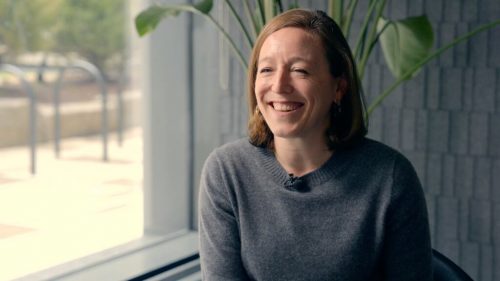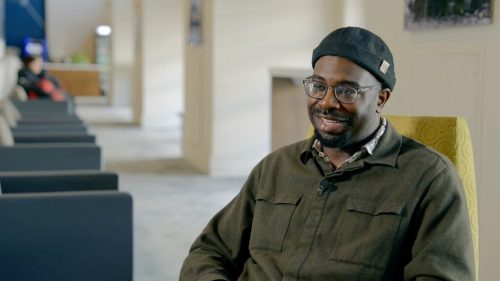Adi Ignatius helped lead Harvard Business Review into the digital age over the past 16 years as its editor in chief. Now, Amy Bernstein is taking over, with a goal of making the Brighton-based publication even more digitally nimble in the age of artificial intelligence.
“If Adi amped up our metabolism for the 2000s, now we have to amp it up even further for the 2020s and 2030s,” Bernstein said. “What we will not change is the [way] we vet and develop the most important ideas for senior leaders.”
Bernstein came to HBR in 2011 as a top editor after a long media career in New York, Washington, and San Francisco and then working on “thought leadership” for consultancy Booz Allen and then for Manpower, the staffing and recruitment firm. In the latter role, she noticed that top executives all had copies of Harvard Business Review on coffee tables in their offices. Impressed by HBR’s influence, she started subscribing (though she confesses to borrowing ideas from HBR for years before that point). So when she got the call about a job editing the magazine nearly 14 years ago, she considered it a dream opportunity.
Now, as editor in chief, she’ll oversee all of the content that the HBR staff produces, digital and in print. Ignatius is staying on board, as editor at large, in part to help launch a new premium product offering additional insights, videos, and classes to C-suite types.
Bernstein’s goals will include growing HBR’s paid circulation of 343,000 while developing new ways to present and integrate all its various channels, including books, newsletters, podcasts, and social media posts. Despite HBR’s access to top experts in the fields of business management, she said HBR faces competition on a number of fronts including the low- or no-cost “just good enough” advice that’s widely available online in part because of AI.
“What I want to try to do differently is update the playbook for an audience that is 100 percent digital,” Bernstein said. “I want to make sure we are not just staying abreast of [trends] but anticipating how our audience behavior is going to evolve. . . . I don’t think any media brand covers management and leadership the way we do.”
Chamber members head back to school
Mary Skipper now owes Jim Rooney a dinner.
The two civic leaders — Boston’s schools superintendent and the chief executive of the Greater Boston Chamber of Commerce — made a lighthearted bet in advance of the Principal Partners event on Thursday that brought business leaders together to shadow school superintendents. Rooney told Skipper: You line up the school principals, and I’ll find the businesspeople. Skipper said she thought she would end up with more principals than chamber members. Rooney bet her a dinner that he would win.
Time to pay up? The final count, per a chamber spokesperson: 93 business leaders were matched with 87 principals across 86 schools. (One school has two principals.) Rooney wound up at his alma mater, Boston Latin School, shadowing BLS principal Jason Gallagher, along with Babson College executive vice president Katherine Craven, another BLS alum.
Ever since Rooney became the chamber’s chief executive a decade ago, he has tried to better integrate the business community and Boston Public Schools. Some companies, such as Natixis and Vertex Pharmaceuticals, already had specific partnerships established. But Rooney found it hard to make much traction for a broader chamber effort.
Then came Skipper, who was tapped by Mayor Michelle Wu in 2022 to lead BPS. Skipper and Rooney already knew each other; they live on the same street in Dorchester. So they hit it off quite easily. Among the fruits of those discussions: an agreement to help develop a financial literacy curriculum, to be rolled out this fall, and the Principal Partners shadowing event, reviving a concept similar to the “Principal for a Day” program last tried in 2018.
On Thursday, the business leaders shadowed principals throughout the morning, then came together at Bank of America’s offices on Federal Street to debrief. Rooney, Skipper, and Wu all spoke, as did B of A executive Miceal Chamberlain.
“Historically, the School Department has been hard to help,” Rooney said. “In the past, they defined ‘partnership’ as ‘write me a check.’ [Businesses] will do that as a matter of goodwill. But I wanted to do something deeper than that.”
Kraft Group gets high-tech upgrade

There’s a new corporate name beaming from the Gillette Stadium jumbotron: NWN.
The Boston IT provider last week announced a five-year partnership with The Kraft Group that involves overhauling the tech systems throughout the Krafts’ businesses, including its packaging manufacturing and sports operations. Terms of the deal aren’t being disclosed, but it comes with signage rights at Gillette in Foxborough.
The work started earlier this year, with a replacement of the Krafts’ communications systems. With NWN’s artificial intelligence expertise, the potential for this deal goes well beyond making phone calls. Among other things, Kraft Group chief information officer Mike Israel sees efficiency savings at a Rand-Whitney factory in Montville, by tracking how long trucks sit in loading docks, and a more fun experience at Gillette, by giving fans the opportunity to use facial recognition to access their digital wallets and “unlock” their game tickets or buy concessions. The AI tech can also be used to spot when someone climbs a fence, or when a stadium bathroom needs to be restocked.
Israel said Robert Kraft and son Jonathan Kraft, the company’s top two executives, are pushing the Kraft Group to be more creative and entrepreneurial.
“There’s that drive to move fast and be adaptive,” Israel added. “That comes right now from the top. That pushes us forward at lightning speed in terms of innovation.”
The Kraft Group represents a high-profile customer for NWN, which cleared about $1 billion in sales last year. The Kraft Group, NWN chief executive Jim Sullivan noted, is one of the largest private companies in the country. “It’s a great fit,” Sullivan said. “We’re incredibly appreciative of the opportunity.”
P&G Gillette looks sharp in Andover

After unveiling an ambitious plan to redevelop its South Boston campus, executives at P&G Gillette on Thursday turned their focus to their other local campus.
The company gathered a crowd under a tent at its Andover site, where it currently makes shaving gels and foams, for a groundbreaking to celebrate the start of a 200,000-square-foot building where much of the blade manufacturing work in South Boston will end up.
About 200 people work in Andover now, at a roughly 600,000-square-foot complex on the 150-acre property; the Andover workforce will more than double once Gillette moves its manufacturing out of Boston. The corporate, design, and engineering functions will remain in South Boston. The transition is expected to begin in the next year or two, though it will take a decade or more to redevelop the South Boston campus.
Gary Coombe, chief executive of P&G’s grooming division, said the Andover project proves that the company is investing not just in its blades and razor business but also in the future of US manufacturing and in the future of Greater Boston.
For Lieutenant Governor Kim Driscoll, the Andover expansion shows the importance of ensuring Massachusetts remains competitive for advanced manufacturing. With the 250th anniversary of the battles against the British troops in Lexington and Concord being celebrated in both towns last week, Driscoll made sure to drop a few Revolution references in her speech, along with a joking apology to Coombe, for going to war against his home country. (Coombe is a UK native.)
“We want to make sure that revolutionary spirit that guided us 250 years ago continues,” Driscoll said. “Guess what? It will, on this site.”
Senator Barry Finegold of Andover also joked with Coombe, thanking him for making his favorite razor.
“I’ve got to take a point of personal privilege, as we say: I want to personally thank you,” the clean-shaven Finegold said. “I’m a Fusion5 guy. Every morning, I get the blades, and also the shaving cream. So thank you for keeping me clean for all these years. I appreciate that.”
Top AstraZeneca exec sees more growth for drug giant in Greater BostonBankFive chief executive is making waves on the South CoastChristine Morin takes over Cradles to Crayons from founder Lynn Margherio




Comment count: